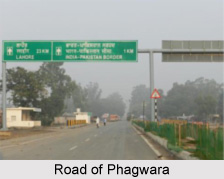 Phagwara is a city in Kapurthala District of Punjab. This city is a dwelling place of many rich Punjabis, who are especially non resident Indians.
Phagwara is a city in Kapurthala District of Punjab. This city is a dwelling place of many rich Punjabis, who are especially non resident Indians.
Phagwara recently became Municipal Corporation in Kapurthala district in North India, in the central part of the Punjab. Phagwara is internationally recognized because a large amount of NRI (Non-resident Indian) population belongs to this city. Before Phagwara was into Kapurthala district it was part of Jalandhar district.
Location of Phagwara
Phagwara lies on the Delhi-Amritsar national highway No.01 and is also served by the rail link between Delhi and Amritsar. Phagwara is located between the two big cities of Ludhiana and Jalandhar. Phagwara is 76 miles away from Chandigarh and 220 miles from Delhi. Phagwara railway station is a junction, with rail and road links to other cities as well.
History of Phagwara
Phagwara was built by the Mughal Emperor Shah Jahan as a market town. Over time, some people of Phagwara started farming and Phagwara took on a rural character. Phagwara Sharki covers the original rural area of Phagwara, which now is only covered by the area surrounding Sukhchainiana Gurdwara (Sukhchain Nagar) where some people continue to farm the land. In the year 1772 it became Part of the Ahluwalia Sikh Dynasty of Kapurthala. The Sixth Sikh Guru, Shri Guru Hargobind Sahib Ji visited this place in 1635 after winning the battle of Kartarpur and Palahi. Phagu, a great devotee of Guru Ji used to reside here. Narur is the famous and big village in Phagwara. Jama Masjid was built by then Maharaj Kapurthala. Its main door is facing towards east in Mohalla Atishbazan and other west side door is on Gaushala road.
Demography of Phagwara
Phagwara has an urban agglomeration and had a population of 117,954, out of which males were 62,171 and females were 55,783. The literacy rate was 87.43 per cent. As of 2001 India census, Phagwara had a population of 95,626. Males constitute 54% of the population and females 46%. Phagwara has an average literacy rate of 81%, higher than the national average of 59.5%: male literacy is 80%, and female literacy is 73%. In Phagwara, 10% of the population is under 6 years of age.



















